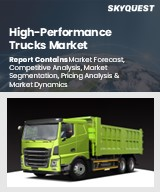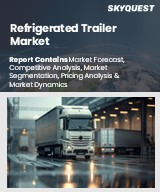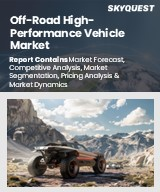
|
시장보고서
상품코드
1511291
세계의 클래스 4 트럭 시장 예측(-2030년) : 제품별, 연료별, GVWR별, 소유권별, 용도별, 지역별Class 4 Truck Market Forecasts to 2030 - Global Analysis By Product, Fuel, Gross Vehicle Weight Rating, Ownership, Application and by Geography |
||||||
Stratistics MRC에 따르면, 세계 4등급 트럭 시장은 2024년 60억 8,000만 달러에 이르고, 예측 기간 동안 8.50%의 연평균 복합 성장률(CAGR)로 성장하여 2030년에는 99억 1,000만 달러에 달할 것으로 예상됩니다.
중형 트럭(클래스 4 트럭)은 상용차 시장에서 중요한 역할을 하고 있습니다. 이 트럭의 총중량(GVWR)은 일반적으로 14,001-16,000파운드입니다. 이 트럭은 소규모 견인 및 운송에서 지역 배송 및 유틸리티 작업에 이르기까지 모든 것을 처리할 수 있는 적응력이 뛰어난 주력 차량입니다. 또한, 클래스 4 트럭은 적당한 크기와 견고한 구조로 기동성과 적재 능력의 균형을 이루며, 도시 도로에서의 기동성 및 무거운 짐을 견인하는 데 이상적입니다.
미국 트럭협회(ATA)에 따르면, 트럭 운송 산업은 미국 경제의 근간을 이루는 산업으로, 전국의 기업과 지역사회를 지탱하는 물자를 운송하는 역할을 담당하고 있습니다.
도시 지역 배송 관련 서비스에 대한 수요 증가
전자상거래의 성장으로 신속하고 효과적인 도시 배송 서비스에 대한 수요가 증가하고 있습니다. 클래스4 트럭은 도심을 쉽게 이동할 수 있어 라스트마일 배송 서비스에 적합한 선택입니다. 또한, 온라인 쇼핑의 성장과 당일 배송에 대한 기대감으로 인해 도시 물류에 대한 수요가 증가함에 따라 기업들은 클래스 4 트럭의 보유량을 늘리고 있습니다.
고가의 구매 가격
4등급 트럭은 일반적으로 소형 차량보다 구매 가격이 높으며, 특히 예산이 한정된 차량 관리자나 중소기업의 경우, 4등급 트럭은 고비용이 될 수 있습니다. 일부 구매 희망자는 클래스 4 트럭 구매에 필요한 초기 투자 및 장비 장착 및 커스터마이징을 위한 추가 비용으로 인해 시장 진입 및 차량 확장에 어려움을 겪을 수 있습니다. 또한, 클래스 4 트럭과 관련된 경제적 부담은 연료, 보험 및 유지보수 비용을 포함한 총 소유 비용으로 인해 더욱 증가합니다.
친환경 운송수단에 대한 관심 증가
4등급 트럭은 환경 지속가능성과 탄소 배출량 감소에 대한 관심이 높아짐에 따라 보다 친환경적인 운송 옵션으로 이동하는 추세에서 큰 기회를 얻을 수 있습니다. 제조업체는 대체 연료, 하이브리드 또는 전기로 구동되는 클래스4 트럭 생산에 투자함으로써 이러한 추세를 활용할 수 있습니다. 또한, 제조업체는 배출량이 적고 환경에 미치는 영향이 적은 차량을 제공함으로써 지속 가능한 운송 솔루션을 찾는 환경 친화적 인 소비자와 기업 증가하는 수요를 충족시킬 수 있습니다.
시장 포화 및 경쟁 압력
경쟁이 치열한 4종 트럭 시장에서 많은 트럭 제조업체들이 시장 점유율과 고객의 관심을 끌기 위해 경쟁하고 있습니다. 치열한 경쟁으로 인해 제조업체는 제품을 차별화하고 고객을 유치하기 위해 노력하게 되고, 그 결과 가격 압박, 마진 축소, 마케팅 비용 증가로 이어질 수 있습니다. 또한 특정 지역이나 시장 부문 시장 포화는 성장 전망을 제한하고 제조업체가 성장을 유지하기 위해 다른 시장이나 틈새 시장으로 눈을 돌리게 할 수 있습니다.
COVID-19의 영향 :
4종 트럭 시장은 코로나19 사태로 인해 공급망 혼란, 생산 지연, 수요 변동으로 인해 큰 영향을 받고 있습니다. 봉쇄 조치와 경제 활동 감소로 인해 많은 기업들이 차량 확장 및 업그레이드 프로젝트를 연기하거나 중단함에 따라 4등급 트럭의 판매량이 감소했습니다. 또한 이동 제한 및 사회적 거리두기 정책은 물류 및 운송 업무에 영향을 미쳐 특히 건설, 접객업, 소매업과 같은 산업에서 4종 트럭의 사용에 영향을 미쳤습니다.
예측 기간 동안 도시 배송 부문이 가장 큰 비중을 차지할 것으로 예상됩니다.
4종 트럭 시장에서 가장 큰 비중을 차지하는 분야는 일반적으로 도심 배송입니다. 이 트럭은 기동성과 접근성이 뛰어나 혼잡한 도심을 이동하며 고객이나 기업에 효율적으로 상품을 배송하는 데 이상적입니다. 또한, 첨단 안전 기능, 저연비 엔진, 인체공학적 촉진제 캐빈을 갖춘 클래스 4 트럭은 전자상거래의 성장과 당일 및 익일 배송 서비스에 대한 수요 증가로 인해 도심 배송 부문에서 점점 더 인기를 얻고 있습니다.
전기 부문은 예측 기간 동안 가장 높은 CAGR을 나타낼 것으로 예상됩니다.
4종 트럭 시장에서 전기 부문은 가장 높은 CAGR로 성장하고 있습니다. 최근 몇 년동안 지속가능성에 대한 관심이 높아지고 탄소 배출량을 줄여야 할 필요성이 증가함에 따라 전기 4등급 트럭의 인기가 눈에 띄게 증가하고 있습니다. 또한, 배터리와 전기 모터로 구동되는 이 트럭은 단거리 운송 및 도시 배송에 있어 무공해 운송 옵션을 제공합니다. 배터리 기술의 발전, 전기자동차 채택을 장려하는 정부 인센티브, 충전 인프라의 확대로 인해 전기 부문은 빠르게 성장하고 있습니다.
가장 큰 점유율을 가진 지역 :
북미가 클래스 4 트럭 시장에서 가장 큰 시장 점유율을 차지하고 있습니다. 북미는 건설, 유틸리티, 운송 서비스, 지자체 등 다양한 산업 분야에서 큰 수요를 바탕으로 4종 트럭 시장에서 세계 선두를 달리고 있습니다. 이 지역은 강력한 산업 인프라, 호황을 누리고 있는 물류 부문, 광활한 도로 교통망을 자랑합니다. 또한, 효율성, 신뢰성, 적응성을 최우선으로 하는 클래스 4 트럭은 북미 대륙에서 도시 배송, 유틸리티 유지보수 및 상업용 운송 요건에 널리 사용되고 있습니다.
CAGR이 가장 높은 지역 :
4종 트럭 시장에서는 아시아태평양이 가장 높은 CAGR을 보이고 있습니다. 중형 트럭에 대한 수요는 경제 활동 증가, 급속한 도시화, 지방 자치 단체 서비스, 건설 및 물류를 포함한 많은 산업 분야의 인프라 개발에 의해 주도되고 있습니다. 또한 도시 인구 증가, 급성장하는 전자상거래 부문, 교통 인프라를 업데이트하려는 정부의 이니셔티브는 중국, 인도, 동남아시아 국가를 포함한 아시아태평양의 신흥 경제권에서 상용차 판매의 큰 성장을 가속하고 있습니다.
히노자동차
무료 커스터마이징 서비스
이 보고서를 구독하는 고객은 다음과 같은 무료 맞춤화 옵션 중 하나를 사용할 수 있습니다.
- 기업 프로파일
- 추가 시장 기업의 종합적인 프로파일링(최대 3개사)
- 주요 기업의 SWOT 분석(최대 3개사)
- 지역 세분화
- 고객의 관심에 따른 주요 국가별 시장 추정치, 예측, CAGR(주: 타당성 확인에 따라 다름)
- 경쟁사 벤치마킹
- 제품 포트폴리오, 지리적 입지, 전략적 제휴를 기반으로 한 주요 기업 벤치마킹
목차
제1장 주요 요약
제2장 서문
- 개요
- 이해관계자
- 조사 범위
- 조사 방법
- 데이터 마이닝
- 데이터 분석
- 데이터 검증
- 조사 접근
- 조사 정보원
- 1차 조사 정보원
- 2차 조사 정보원
- 전제조건
제3장 시장 동향 분석
- 성장 촉진요인
- 성장 억제요인
- 기회
- 위협
- 제품 분석
- 용도 분석
- 신흥 시장
- COVID-19의 영향
제4장 Porter의 Five Forces 분석
- 공급 기업의 교섭력
- 바이어의 교섭력
- 대체품의 위협
- 신규 진출업체의 위협
- 경쟁 기업간 경쟁 관계
제5장 세계의 클래스 4 트럭 시장 : 제품별
- Large Walk-in
- Box Truck
- City Delivery
- 기타
제6장 세계의 클래스 4 트럭 시장 : 연료별
- 디젤
- 천연가스
- 하이브리드
- 전기
- 기타
제7장 세계의 클래스 4 트럭 시장 : GVWR별
- 클래스 4a
- 클래스 4b
제8장 세계의 클래스 4 트럭 시장 : 소유별
- 플릿 오퍼레이터
- 독립계 오퍼레이터
- 정부기관
- 렌탈 및 리스 기업
- 제조업체 및 딜러
- 기타
제9장 세계의 클래스 4 트럭 시장 : 용도별
- 도시 배달
- 냉장 운송
- 건설
- 유틸리티
- 기타
제10장 세계의 클래스 4 트럭 시장 : 지역별
- 북미
- 미국
- 캐나다
- 멕시코
- 유럽
- 독일
- 영국
- 이탈리아
- 프랑스
- 스페인
- 기타 유럽
- 아시아태평양
- 일본
- 중국
- 인도
- 호주
- 뉴질랜드
- 한국
- 기타 아시아태평양
- 남미
- 아르헨티나
- 브라질
- 칠레
- 기타 남미
- 중동 및 아프리카
- 사우디아라비아
- 아랍에미리트(UAE)
- 카타르
- 남아프리카공화국
- 기타 중동 및 아프리카
제11장 주요 발전
- 계약/파트너십/협업/합작투자(JV)
- 인수와 합병
- 신제품 발매
- 사업 확대
- 기타 주요 전략
제12장 기업 프로파일링
- General Motors
- Navistar International Corporation
- Tata Motors
- Ford Motor Company
- Volvo Group
- Mitsubishi Fuso Truck and Bus Corporation
- Scania AB
- Isuzu Motors Ltd.
- Mahindra & Mahindra Ltd.
- Ram Trucks(Stellantis)
- Daimler Trucks North America LLC
- Hino Motors Ltd.
LSH 24.07.19
According to Stratistics MRC, the Global Class 4 Truck Market is accounted for $6.08 billion in 2024 and is expected to reach $9.91 billion by 2030 growing at a CAGR of 8.50% during the forecast period. Medium-duty trucks, or class 4 trucks, fill a crucial role in the commercial vehicle market. The gross vehicle weight rating (GVWR) of these trucks usually falls between 14,001 and 16,000 pounds. They are adaptable workhorses, capable of doing everything from small-scale towing and transportation to local delivery and utility work. Moreover, class 4 trucks balance maneuverability and payload capacity with their moderate size and sturdy build, making them ideal for maneuvering through urban streets and towing heavy loads.
According to the American Trucking Associations (ATA), the trucking industry is the backbone of the American economy, responsible for transporting goods that sustain businesses and communities nationwide.
Market Dynamics:
Driver:
Growing need for services related to urban delivery
The growth of e-commerce has increased demand for prompt and effective urban delivery services. Class 4 trucks are a great option for last-mile delivery services because they can maneuver easily through city streets. Additionally, in response to the increasing demand for urban logistics, businesses are growing their fleets of Class 4 trucks as a result of the growth of online shopping and the expectation of same-day delivery.
Restraint:
Hefty purchase price up front
Class 4 trucks typically cost more to buy outright than smaller cars, which can be prohibitive, particularly for fleet managers and small businesses with tight budgets. Some prospective buyers may be discouraged from entering the market or growing their fleets due to the initial investment required to purchase Class 4 trucks, as well as additional costs for equipment installation and customization. Furthermore, the financial burden associated with Class 4 trucks is further increased by the total cost of ownership, which includes fuel, insurance, and maintenance costs.
Opportunity:
Growing interest in environmentally friendly transportation options
Class 4 trucks have a big chance to benefit from the move towards greener transportation options, given the rising concerns about environmental sustainability and the need to cut carbon emissions. By making investments in the creation of Class 4 trucks that run on alternative fuels, hybrids, or electricity, manufacturers can take advantage of this trend. Moreover, manufacturers can meet the growing demand from environmentally conscious consumers and businesses for sustainable transportation solutions by providing vehicles with lower emissions and less of an impact on the environment.
Threat:
Market saturation and competitive pressures
There are many truck manufacturers fighting for market share and customer attention in the fiercely competitive Class 4 truck market. Intense competition can cause manufacturers to strive to differentiate their products and draw in customers, which can result in pricing pressures, margin erosion, and increased marketing expenses. Furthermore, market saturation in specific areas or market segments can restrict prospects for growth and compel manufacturers to look into other markets or niche markets in order to maintain growth.
Covid-19 Impact:
The Class 4 truck market has been significantly impacted by the COVID-19 pandemic, which has resulted in supply chain disruptions, production delays, and demand fluctuations. Sales of Class 4 trucks decreased as a result of numerous companies delaying or cancelling fleet expansion and upgrade projects as lockdown measures were implemented and economic activity decreased. Moreover, mobility limitations and social distancing policies impacted logistics and transportation operations, which in turn affected the use of Class 4 trucks, especially in industries like construction, hospitality, and retail.
The City Delivery segment is expected to be the largest during the forecast period
In the Class 4 truck market, city delivery usually commands the largest share. Because of their mobility and accessibility, these trucks are ideal for navigating crowded city streets and effectively delivering goods to customers and businesses. Additionally, Class 4 trucks with advanced safety features, fuel-efficient engines, and ergonomic driver cabins are becoming more and more popular in the city delivery segment due to the growth of e-commerce and the growing demand for same-day and next-day delivery services.
The Electric segment is expected to have the highest CAGR during the forecast period
In the Class 4 truck market, the electric segment is growing at the highest CAGR. Recent years have seen a notable increase in the popularity of electric Class 4 trucks due to the growing emphasis on sustainability and the need to reduce carbon emissions. Furthermore, these trucks provide zero-emission transportation options for short-haul and urban delivery because they are battery- and electric motor-powered. Due to advancements in battery technology, government incentives encouraging the adoption of electric vehicles, and the expansion of charging infrastructure, the electric segment is growing rapidly.
Region with largest share:
North America holds the largest market share for Class 4 trucks. Due to the substantial demand from numerous industries, including construction, utilities, delivery services, and municipal applications, North America leads the world in the Class 4 truck market. The region boasts a strong industrial infrastructure, a booming logistics sector, and a vast network of road transportation. Moreover, class 4 trucks, which prioritize efficiency, dependability, and adaptability, are widely used on the continent for urban delivery, utility maintenance, and commercial transportation requirements.
Region with highest CAGR:
In the Class 4 truck market, the Asia-Pacific region has the highest CAGR. The demand for medium-duty trucks is being driven by rising economic activity, rapid urbanization, and infrastructure development in a number of industries, including municipal services, construction, and logistics. Additionally, rising urban populations, burgeoning e-commerce sectors, and government initiatives to update transportation infrastructure are driving substantial growth in commercial vehicle sales in emerging economies within the Asia-Pacific region, including China, India, and Southeast Asian nations.
Key players in the market
Some of the key players in Class 4 Truck market include General Motors, Navistar International Corporation, Tata Motors, Ford Motor Company, Volvo Group, Mitsubishi Fuso Truck and Bus Corporation, Scania AB, Isuzu Motors Ltd., Mahindra & Mahindra Ltd., Ram Trucks (Stellantis), Daimler Trucks North America LLC.
Hino Motors Ltd.
Key Developments:
In May 2024, Tata Motors and South Indian Bank have entered into a memorandum of understanding (MoU) to provide accessible financing solutions to commercial vehicle customers and dealerships. Under this agreement, South Indian Bank will extend financing services across Tata Motors' complete commercial vehicle range, leveraging its extensive network and tailored repayment options.
In January 2024, Volvo Group has signed an option agreement with John Cockerill Defense, which gives the Volvo Group the right to sell French military vehicle maker Arquus after mandatory consultations with staff representative bodies. The consultations are expected to be finalized in Q1 2024. The amount of the agreement was not disclosed.
In October 2023, General Motors and the United Auto Workers union have reached a tentative contract agreement that could end a six-week-old strike against Detroit automakers, a person briefed on the deal said Monday. The deal follows the pattern set with Ford last week and Jeep maker Stellantis over the weekend.
Products Covered:
- Large Walk-in
- Box Truck
- City Delivery
- Other Products
Fuels Covered:
- Diesel
- Natural Gas
- Hybrid
- Electric
- Other Fuels
Gross Vehicle Weight Ratings Covered:
- Class 4a
- Class 4b
Ownerships Covered:
- Fleet Operator
- Independent Operator
- Government Agencies
- Rental and Leasing Companies
- Manufacturers and Dealerships
- Other Ownerships
Applications Covered:
- Urban Delivery
- Refrigerated Transport
- Construction
- Utilities
- Other Applications
Regions Covered:
- North America
- US
- Canada
- Mexico
- Europe
- Germany
- UK
- Italy
- France
- Spain
- Rest of Europe
- Asia Pacific
- Japan
- China
- India
- Australia
- New Zealand
- South Korea
- Rest of Asia Pacific
- South America
- Argentina
- Brazil
- Chile
- Rest of South America
- Middle East & Africa
- Saudi Arabia
- UAE
- Qatar
- South Africa
- Rest of Middle East & Africa
What our report offers:
- Market share assessments for the regional and country-level segments
- Strategic recommendations for the new entrants
- Covers Market data for the years 2022, 2023, 2024, 2026, and 2030
- Market Trends (Drivers, Constraints, Opportunities, Threats, Challenges, Investment Opportunities, and recommendations)
- Strategic recommendations in key business segments based on the market estimations
- Competitive landscaping mapping the key common trends
- Company profiling with detailed strategies, financials, and recent developments
- Supply chain trends mapping the latest technological advancements
Free Customization Offerings:
All the customers of this report will be entitled to receive one of the following free customization options:
- Company Profiling
- Comprehensive profiling of additional market players (up to 3)
- SWOT Analysis of key players (up to 3)
- Regional Segmentation
- Market estimations, Forecasts and CAGR of any prominent country as per the client's interest (Note: Depends on feasibility check)
- Competitive Benchmarking
- Benchmarking of key players based on product portfolio, geographical presence, and strategic alliances
Table of Contents
1 Executive Summary
2 Preface
- 2.1 Abstract
- 2.2 Stake Holders
- 2.3 Research Scope
- 2.4 Research Methodology
- 2.4.1 Data Mining
- 2.4.2 Data Analysis
- 2.4.3 Data Validation
- 2.4.4 Research Approach
- 2.5 Research Sources
- 2.5.1 Primary Research Sources
- 2.5.2 Secondary Research Sources
- 2.5.3 Assumptions
3 Market Trend Analysis
- 3.1 Introduction
- 3.2 Drivers
- 3.3 Restraints
- 3.4 Opportunities
- 3.5 Threats
- 3.6 Product Analysis
- 3.7 Application Analysis
- 3.8 Emerging Markets
- 3.9 Impact of Covid-19
4 Porters Five Force Analysis
- 4.1 Bargaining power of suppliers
- 4.2 Bargaining power of buyers
- 4.3 Threat of substitutes
- 4.4 Threat of new entrants
- 4.5 Competitive rivalry
5 Global Class 4 Truck Market, By Product
- 5.1 Introduction
- 5.2 Large Walk-in
- 5.3 Box Truck
- 5.4 City Delivery
- 5.5 Other Products
6 Global Class 4 Truck Market, By Fuel
- 6.1 Introduction
- 6.2 Diesel
- 6.3 Natural Gas
- 6.4 Hybrid
- 6.5 Electric
- 6.6 Other Fuels
7 Global Class 4 Truck Market, By Gross Vehicle Weight Rating
- 7.1 Introduction
- 7.2 Class 4a
- 7.3 Class 4b
8 Global Class 4 Truck Market, By Ownership
- 8.1 Introduction
- 8.2 Fleet Operator
- 8.3 Independent Operator
- 8.4 Government Agencies
- 8.5 Rental and Leasing Companies
- 8.6 Manufacturers and Dealerships
- 8.7 Other Ownerships
9 Global Class 4 Truck Market, By Application
- 9.1 Introduction
- 9.2 Urban Delivery
- 9.3 Refrigerated Transport
- 9.4 Construction
- 9.5 Utilities
- 9.6 Other Applications
10 Global Class 4 Truck Market, By Geography
- 10.1 Introduction
- 10.2 North America
- 10.2.1 US
- 10.2.2 Canada
- 10.2.3 Mexico
- 10.3 Europe
- 10.3.1 Germany
- 10.3.2 UK
- 10.3.3 Italy
- 10.3.4 France
- 10.3.5 Spain
- 10.3.6 Rest of Europe
- 10.4 Asia Pacific
- 10.4.1 Japan
- 10.4.2 China
- 10.4.3 India
- 10.4.4 Australia
- 10.4.5 New Zealand
- 10.4.6 South Korea
- 10.4.7 Rest of Asia Pacific
- 10.5 South America
- 10.5.1 Argentina
- 10.5.2 Brazil
- 10.5.3 Chile
- 10.5.4 Rest of South America
- 10.6 Middle East & Africa
- 10.6.1 Saudi Arabia
- 10.6.2 UAE
- 10.6.3 Qatar
- 10.6.4 South Africa
- 10.6.5 Rest of Middle East & Africa
11 Key Developments
- 11.1 Agreements, Partnerships, Collaborations and Joint Ventures
- 11.2 Acquisitions & Mergers
- 11.3 New Product Launch
- 11.4 Expansions
- 11.5 Other Key Strategies
12 Company Profiling
- 12.1 General Motors
- 12.2 Navistar International Corporation
- 12.3 Tata Motors
- 12.4 Ford Motor Company
- 12.5 Volvo Group
- 12.6 Mitsubishi Fuso Truck and Bus Corporation
- 12.7 Scania AB
- 12.8 Isuzu Motors Ltd.
- 12.9 Mahindra & Mahindra Ltd.
- 12.10 Ram Trucks (Stellantis)
- 12.11 Daimler Trucks North America LLC
- 12.12 Hino Motors Ltd.
- 추가 시장 기업의 종합적인 프로파일링(최대 3개사)
- 주요 기업의 SWOT 분석(최대 3개사)
- 고객의 관심에 따른 주요 국가별 시장 추정치, 예측, CAGR(주: 타당성 확인에 따라 다름)
- 제품 포트폴리오, 지리적 입지, 전략적 제휴를 기반으로 한 주요 기업 벤치마킹
- 데이터 마이닝
- 데이터 분석
- 데이터 검증
- 조사 접근
- 1차 조사 정보원
- 2차 조사 정보원
- 전제조건
- 미국
- 캐나다
- 멕시코
- 독일
- 영국
- 이탈리아
- 프랑스
- 스페인
- 기타 유럽
- 일본
- 중국
- 인도
- 호주
- 뉴질랜드
- 한국
- 기타 아시아태평양
- 아르헨티나
- 브라질
- 칠레
- 기타 남미
- 사우디아라비아
- 아랍에미리트(UAE)
- 카타르
- 남아프리카공화국
- 기타 중동 및 아프리카
According to Stratistics MRC, the Global Class 4 Truck Market is accounted for $6.08 billion in 2024 and is expected to reach $9.91 billion by 2030 growing at a CAGR of 8.50% during the forecast period. Medium-duty trucks, or class 4 trucks, fill a crucial role in the commercial vehicle market. The gross vehicle weight rating (GVWR) of these trucks usually falls between 14,001 and 16,000 pounds. They are adaptable workhorses, capable of doing everything from small-scale towing and transportation to local delivery and utility work. Moreover, class 4 trucks balance maneuverability and payload capacity with their moderate size and sturdy build, making them ideal for maneuvering through urban streets and towing heavy loads.
According to the American Trucking Associations (ATA), the trucking industry is the backbone of the American economy, responsible for transporting goods that sustain businesses and communities nationwide.
Market Dynamics:
Driver:
Growing need for services related to urban delivery
The growth of e-commerce has increased demand for prompt and effective urban delivery services. Class 4 trucks are a great option for last-mile delivery services because they can maneuver easily through city streets. Additionally, in response to the increasing demand for urban logistics, businesses are growing their fleets of Class 4 trucks as a result of the growth of online shopping and the expectation of same-day delivery.
Restraint:
Hefty purchase price up front
Class 4 trucks typically cost more to buy outright than smaller cars, which can be prohibitive, particularly for fleet managers and small businesses with tight budgets. Some prospective buyers may be discouraged from entering the market or growing their fleets due to the initial investment required to purchase Class 4 trucks, as well as additional costs for equipment installation and customization. Furthermore, the financial burden associated with Class 4 trucks is further increased by the total cost of ownership, which includes fuel, insurance, and maintenance costs.
Opportunity:
Growing interest in environmentally friendly transportation options
Class 4 trucks have a big chance to benefit from the move towards greener transportation options, given the rising concerns about environmental sustainability and the need to cut carbon emissions. By making investments in the creation of Class 4 trucks that run on alternative fuels, hybrids, or electricity, manufacturers can take advantage of this trend. Moreover, manufacturers can meet the growing demand from environmentally conscious consumers and businesses for sustainable transportation solutions by providing vehicles with lower emissions and less of an impact on the environment.
Threat:
Market saturation and competitive pressures
There are many truck manufacturers fighting for market share and customer attention in the fiercely competitive Class 4 truck market. Intense competition can cause manufacturers to strive to differentiate their products and draw in customers, which can result in pricing pressures, margin erosion, and increased marketing expenses. Furthermore, market saturation in specific areas or market segments can restrict prospects for growth and compel manufacturers to look into other markets or niche markets in order to maintain growth.
Covid-19 Impact:
The Class 4 truck market has been significantly impacted by the COVID-19 pandemic, which has resulted in supply chain disruptions, production delays, and demand fluctuations. Sales of Class 4 trucks decreased as a result of numerous companies delaying or cancelling fleet expansion and upgrade projects as lockdown measures were implemented and economic activity decreased. Moreover, mobility limitations and social distancing policies impacted logistics and transportation operations, which in turn affected the use of Class 4 trucks, especially in industries like construction, hospitality, and retail.
The City Delivery segment is expected to be the largest during the forecast period
In the Class 4 truck market, city delivery usually commands the largest share. Because of their mobility and accessibility, these trucks are ideal for navigating crowded city streets and effectively delivering goods to customers and businesses. Additionally, Class 4 trucks with advanced safety features, fuel-efficient engines, and ergonomic driver cabins are becoming more and more popular in the city delivery segment due to the growth of e-commerce and the growing demand for same-day and next-day delivery services.
The Electric segment is expected to have the highest CAGR during the forecast period
In the Class 4 truck market, the electric segment is growing at the highest CAGR. Recent years have seen a notable increase in the popularity of electric Class 4 trucks due to the growing emphasis on sustainability and the need to reduce carbon emissions. Furthermore, these trucks provide zero-emission transportation options for short-haul and urban delivery because they are battery- and electric motor-powered. Due to advancements in battery technology, government incentives encouraging the adoption of electric vehicles, and the expansion of charging infrastructure, the electric segment is growing rapidly.
Region with largest share:
North America holds the largest market share for Class 4 trucks. Due to the substantial demand from numerous industries, including construction, utilities, delivery services, and municipal applications, North America leads the world in the Class 4 truck market. The region boasts a strong industrial infrastructure, a booming logistics sector, and a vast network of road transportation. Moreover, class 4 trucks, which prioritize efficiency, dependability, and adaptability, are widely used on the continent for urban delivery, utility maintenance, and commercial transportation requirements.
Region with highest CAGR:
In the Class 4 truck market, the Asia-Pacific region has the highest CAGR. The demand for medium-duty trucks is being driven by rising economic activity, rapid urbanization, and infrastructure development in a number of industries, including municipal services, construction, and logistics. Additionally, rising urban populations, burgeoning e-commerce sectors, and government initiatives to update transportation infrastructure are driving substantial growth in commercial vehicle sales in emerging economies within the Asia-Pacific region, including China, India, and Southeast Asian nations.
Key players in the market
Some of the key players in Class 4 Truck market include General Motors, Navistar International Corporation, Tata Motors, Ford Motor Company, Volvo Group, Mitsubishi Fuso Truck and Bus Corporation, Scania AB, Isuzu Motors Ltd., Mahindra & Mahindra Ltd., Ram Trucks (Stellantis), Daimler Trucks North America LLC.
Hino Motors Ltd.
Key Developments:
In May 2024, Tata Motors and South Indian Bank have entered into a memorandum of understanding (MoU) to provide accessible financing solutions to commercial vehicle customers and dealerships. Under this agreement, South Indian Bank will extend financing services across Tata Motors' complete commercial vehicle range, leveraging its extensive network and tailored repayment options.
In January 2024, Volvo Group has signed an option agreement with John Cockerill Defense, which gives the Volvo Group the right to sell French military vehicle maker Arquus after mandatory consultations with staff representative bodies. The consultations are expected to be finalized in Q1 2024. The amount of the agreement was not disclosed.
In October 2023, General Motors and the United Auto Workers union have reached a tentative contract agreement that could end a six-week-old strike against Detroit automakers, a person briefed on the deal said Monday. The deal follows the pattern set with Ford last week and Jeep maker Stellantis over the weekend.
Products Covered:
- Large Walk-in
- Box Truck
- City Delivery
- Other Products
Fuels Covered:
- Diesel
- Natural Gas
- Hybrid
- Electric
- Other Fuels
Gross Vehicle Weight Ratings Covered:
- Class 4a
- Class 4b
Ownerships Covered:
- Fleet Operator
- Independent Operator
- Government Agencies
- Rental and Leasing Companies
- Manufacturers and Dealerships
- Other Ownerships
Applications Covered:
- Urban Delivery
- Refrigerated Transport
- Construction
- Utilities
- Other Applications
Regions Covered:
- North America
- US
- Canada
- Mexico
- Europe
- Germany
- UK
- Italy
- France
- Spain
- Rest of Europe
- Asia Pacific
- Japan
- China
- India
- Australia
- New Zealand
- South Korea
- Rest of Asia Pacific
- South America
- Argentina
- Brazil
- Chile
- Rest of South America
- Middle East & Africa
- Saudi Arabia
- UAE
- Qatar
- South Africa
- Rest of Middle East & Africa
What our report offers:
- Market share assessments for the regional and country-level segments
- Strategic recommendations for the new entrants
- Covers Market data for the years 2022, 2023, 2024, 2026, and 2030
- Market Trends (Drivers, Constraints, Opportunities, Threats, Challenges, Investment Opportunities, and recommendations)
- Strategic recommendations in key business segments based on the market estimations
- Competitive landscaping mapping the key common trends
- Company profiling with detailed strategies, financials, and recent developments
- Supply chain trends mapping the latest technological advancements
Free Customization Offerings:
All the customers of this report will be entitled to receive one of the following free customization options:
- Company Profiling
- Comprehensive profiling of additional market players (up to 3)
- SWOT Analysis of key players (up to 3)
- Regional Segmentation
- Market estimations, Forecasts and CAGR of any prominent country as per the client's interest (Note: Depends on feasibility check)
- Competitive Benchmarking
- Benchmarking of key players based on product portfolio, geographical presence, and strategic alliances
Table of Contents
1 Executive Summary
2 Preface
- 2.1 Abstract
- 2.2 Stake Holders
- 2.3 Research Scope
- 2.4 Research Methodology
- 2.4.1 Data Mining
- 2.4.2 Data Analysis
- 2.4.3 Data Validation
- 2.4.4 Research Approach
- 2.5 Research Sources
- 2.5.1 Primary Research Sources
- 2.5.2 Secondary Research Sources
- 2.5.3 Assumptions
3 Market Trend Analysis
- 3.1 Introduction
- 3.2 Drivers
- 3.3 Restraints
- 3.4 Opportunities
- 3.5 Threats
- 3.6 Product Analysis
- 3.7 Application Analysis
- 3.8 Emerging Markets
- 3.9 Impact of Covid-19
4 Porters Five Force Analysis
- 4.1 Bargaining power of suppliers
- 4.2 Bargaining power of buyers
- 4.3 Threat of substitutes
- 4.4 Threat of new entrants
- 4.5 Competitive rivalry
5 Global Class 4 Truck Market, By Product
- 5.1 Introduction
- 5.2 Large Walk-in
- 5.3 Box Truck
- 5.4 City Delivery
- 5.5 Other Products
6 Global Class 4 Truck Market, By Fuel
- 6.1 Introduction
- 6.2 Diesel
- 6.3 Natural Gas
- 6.4 Hybrid
- 6.5 Electric
- 6.6 Other Fuels
7 Global Class 4 Truck Market, By Gross Vehicle Weight Rating
- 7.1 Introduction
- 7.2 Class 4a
- 7.3 Class 4b
8 Global Class 4 Truck Market, By Ownership
- 8.1 Introduction
- 8.2 Fleet Operator
- 8.3 Independent Operator
- 8.4 Government Agencies
- 8.5 Rental and Leasing Companies
- 8.6 Manufacturers and Dealerships
- 8.7 Other Ownerships
9 Global Class 4 Truck Market, By Application
- 9.1 Introduction
- 9.2 Urban Delivery
- 9.3 Refrigerated Transport
- 9.4 Construction
- 9.5 Utilities
- 9.6 Other Applications
10 Global Class 4 Truck Market, By Geography
- 10.1 Introduction
- 10.2 North America
- 10.2.1 US
- 10.2.2 Canada
- 10.2.3 Mexico
- 10.3 Europe
- 10.3.1 Germany
- 10.3.2 UK
- 10.3.3 Italy
- 10.3.4 France
- 10.3.5 Spain
- 10.3.6 Rest of Europe
- 10.4 Asia Pacific
- 10.4.1 Japan
- 10.4.2 China
- 10.4.3 India
- 10.4.4 Australia
- 10.4.5 New Zealand
- 10.4.6 South Korea
- 10.4.7 Rest of Asia Pacific
- 10.5 South America
- 10.5.1 Argentina
- 10.5.2 Brazil
- 10.5.3 Chile
- 10.5.4 Rest of South America
- 10.6 Middle East & Africa
- 10.6.1 Saudi Arabia
- 10.6.2 UAE
- 10.6.3 Qatar
- 10.6.4 South Africa
- 10.6.5 Rest of Middle East & Africa
11 Key Developments
- 11.1 Agreements, Partnerships, Collaborations and Joint Ventures
- 11.2 Acquisitions & Mergers
- 11.3 New Product Launch
- 11.4 Expansions
- 11.5 Other Key Strategies
12 Company Profiling
- 12.1 General Motors
- 12.2 Navistar International Corporation
- 12.3 Tata Motors
- 12.4 Ford Motor Company
- 12.5 Volvo Group
- 12.6 Mitsubishi Fuso Truck and Bus Corporation
- 12.7 Scania AB
- 12.8 Isuzu Motors Ltd.
- 12.9 Mahindra & Mahindra Ltd.
- 12.10 Ram Trucks (Stellantis)
- 12.11 Daimler Trucks North America LLC
- 12.12 Hino Motors Ltd.



















